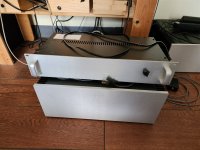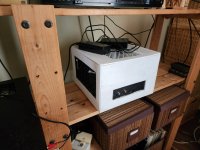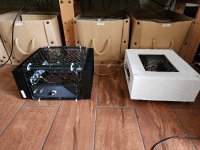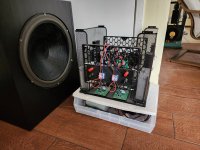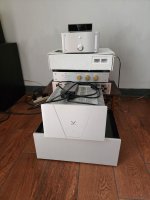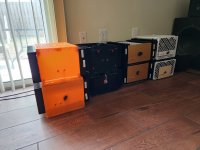I recently sold my house and moved into a smaller place temporarily.
All my belongings are in storage which take up 10ftx20ft and 7ftx10ft spaces. Both completely full.
I quickly realized that 75% to 80% of my belongings are audio and video related gear and parts, followed by computer gear, then tools, then household belongings. To save on storage space, I indefinitely lent out the bulk of my audio gear to a friend and DIYaudio.com member for safe keeping. 😀
Don't exactly remember how many, but he's holding 5 or 6 power amps and at least one DAC. I should have written up a manifest! 🤔
All my belongings are in storage which take up 10ftx20ft and 7ftx10ft spaces. Both completely full.
I quickly realized that 75% to 80% of my belongings are audio and video related gear and parts, followed by computer gear, then tools, then household belongings. To save on storage space, I indefinitely lent out the bulk of my audio gear to a friend and DIYaudio.com member for safe keeping. 😀
Don't exactly remember how many, but he's holding 5 or 6 power amps and at least one DAC. I should have written up a manifest! 🤔
I could use a friend like that but unfortunately the ones I know locally are other sick FABs suffering from the same excess-amp syndrome! 🤢
No, you certainly did not. Just few amplifiers i made, not even talking about pre...A couple of years ago my venerable Hafler DH-200 lost a channel and I thought to myself "I have a soldering iron and a multi-meter, I wonder if I can learn enough to fix it," which led me through the wandering paths of YouTube and many other forums to end up here, at DIYAudio, discovering that not only was it possible to repair the Hafler, but that someone (Bob Cordell) had taken the chassis, power supply and output MOSFETS and built an entirely different amp in between.
The implications were mind blowing. "Wait. There are people who design their own amplifiers? Who build them? There are kits? There are tools for simulating circuits? For laying out and getting PCBs printed yourself? Nelson Pass is actively involved? Oh. Oh, my."
And so I learned to solder a lot better, then re-flow my soldering failures, measure volts and amps and burn up resistors and blow output MOSFETs and ask for (and receive) help over the next year or so and wound up with a variac, isolation transformer, dim bulb tester, even an oscilloscope and got that Cordell DH-200C working andthen crashing and then debugging and repairing and it was glorious. And then I ventured into the PASS forum area.
This place is addictive as hell.
I received the F6 boards for Christmas this time last year, and by way of the build guides and the store and Mouser and Digikey and FirstWatt manuals and other information sources on YouTube, I was able to build it, first amp from the ground up. Did I know how the circuit really worked? Nope, not entirely. Have I since learned? It's becoming more clear. It does take years, but I've got patience.
F6 led to F4 led to B1-Korg and then Randy Thatcher hung out a thread about the classic Aleph 30/60 fit for the DIYAudio chassis mounts. An Aleph was always something I wanted, since I first read about them in Stereophile circa 1990. And here I was, building them, listening to them. I built that!
Next stop? M2X. I originally thought the F6 was what the M2 turned out to be, an amp that used a transformer as a gain stage, but I'd learned enough during the year that I understood the difference. I'm, uh, listening to an M2X now in my office.
And I've got the forthcoming Iron Pre to build. And most of the bits for an F5Turbo-V2 ready, and a moving coil phono stage and then a tube radio I picked up from an antique shop to refurbish and then...
I didn't overdo it, did I?
This is a strange way to say thank you all for having this community. To borrow from Sy's paper about his MC phono stage, it's so much more fun to be a builder than an appliance operator.
Attachments
Looks kinda full. Need some relief?No, you certainly did not. Just few amplifiers i made, not even talking about pre...

Every collection of Class A amps requires an Aleph J for completeness.
Every collection of Class A amps requires an Aleph J for completeness.
Does a 30W AX count?
Every collection of Class A amps requires an Aleph J for completeness.
I think it's the Aleph that counts the most. Any Aleph.Does a 30W AX count?
I built Aleph 60 monoblocks this past year. Authoritative and in control. When the J boards came back in stock this past fall, I whipped one up as well.
I'm going to put together an A40ish in a 5U400 case, pushing it to the limits of what the heatsinks can handle.
But I also haven't built the F5T V2 yet. Gotta get my wife's 1920s Remington Portable typewriter off the workbench. You think there's a niche group of people who love and build audio equipment? Check out the typewriter hobbyists!
Last edited:
Yes, a true FAB cranks the bias current until things start to melt, then backs off a little bit.I'm going to put together an A40ish in a 5U400 case, pushing it to the limits of what the heatsinks can handle.
😉
- Home
- Amplifiers
- Pass Labs
- I don't *think* I overdid it. Did I overdo it? My DIY year in review
